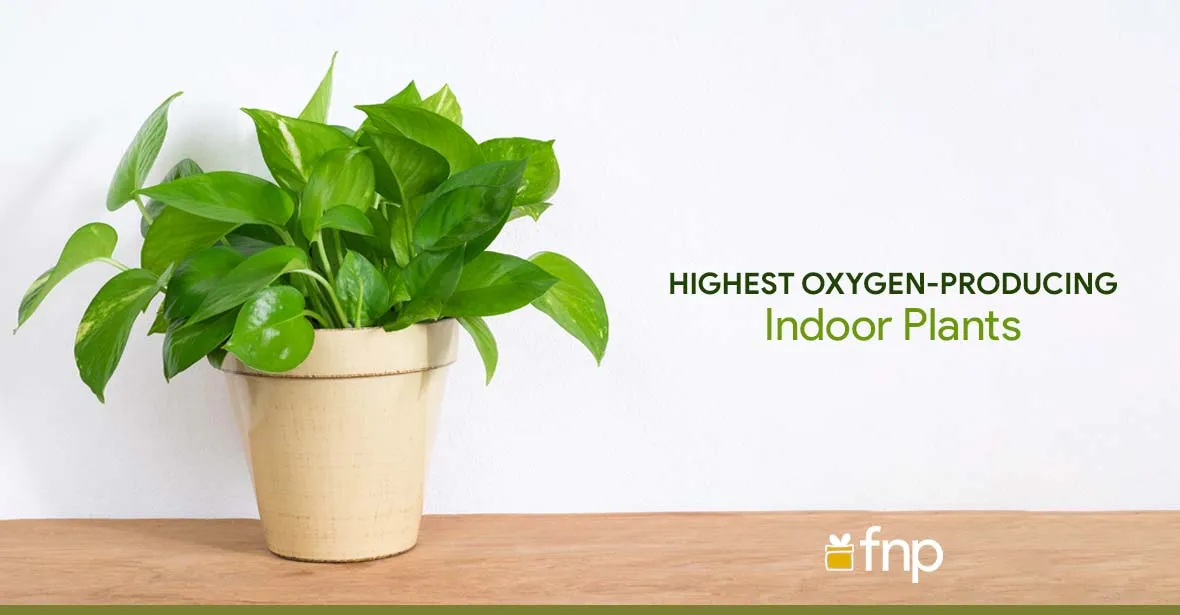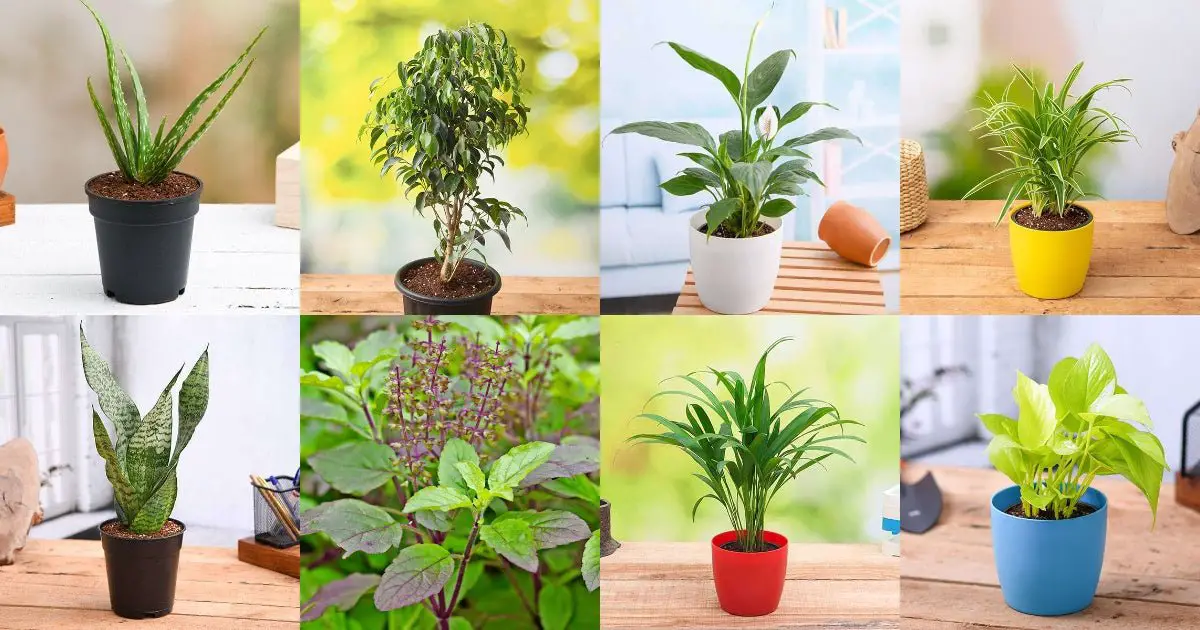The Areca Palm produces the most oxygen among houseplants. This plant is known for its air-purifying capabilities.
Houseplants have become a popular choice for enhancing indoor air quality and adding aesthetic appeal. The Areca Palm stands out for its exceptional oxygen production. This plant not only improves air quality but also adds a tropical touch to any room.
Its lush, feathery fronds are both attractive and functional. Growing the Areca Palm is relatively easy, making it a great option for beginners and seasoned plant enthusiasts alike. It thrives in indirect sunlight and needs regular watering. By incorporating the Areca Palm into your home, you can enjoy cleaner air and a greener living space.

Credit: www.fnp.com
Spider Plant
The Spider Plant is a popular houseplant known for its lush green foliage and easy care. This plant not only beautifies your space but also cleans the air by producing oxygen. Let’s dive into the specifics of this remarkable plant.
Overview
The Spider Plant, scientifically known as Chlorophytum comosum, is native to South Africa. It features long, arching leaves that are usually green with white stripes. The plant grows small white flowers and baby plantlets, often called “spiderettes.”
- Scientific Name: Chlorophytum comosum
- Common Names: Spider Plant, Airplane Plant
- Origin: South Africa
Oxygen Production
The Spider Plant is excellent at producing oxygen. It is a part of NASA’s list of top air-purifying plants. The plant absorbs carbon dioxide and releases oxygen efficiently. This helps to improve indoor air quality.
| Benefit | Description |
|---|---|
| Oxygen Production | High rate of oxygen release |
| Air Purification | Removes toxins like formaldehyde |
Care Tips
Caring for a Spider Plant is simple. Here are some basic tips:
- Light: Prefers bright, indirect sunlight
- Water: Keep the soil moist but not soggy
- Temperature: Thrives in temperatures between 65-75°F
- Soil: Use well-draining potting mix
- Place your Spider Plant in a spot with indirect light.
- Water it once the top inch of soil dries out.
- Ensure the room temperature is comfortable.
- Repot the plant every 2-3 years to refresh the soil.
By following these simple tips, your Spider Plant will thrive and continue to purify the air in your home.
Snake Plant
The Snake Plant, also known as Sansevieria or Mother-in-Law’s Tongue, is a popular houseplant. This resilient plant is not only easy to care for but also highly effective in producing oxygen. Let’s explore the key features of the Snake Plant.
Overview
The Snake Plant features tall, stiff leaves that are typically green with yellow edges. It is known for its striking appearance and low maintenance needs. This plant is native to West Africa and can thrive in various indoor conditions.
Oxygen Production
The Snake Plant is one of the best plants for oxygen production. It performs photosynthesis during the day and night. This unique ability makes it an excellent choice for improving indoor air quality. It converts carbon dioxide into oxygen, making the air fresher and healthier.
According to research, the Snake Plant can produce oxygen and remove harmful toxins like formaldehyde, benzene, and xylene from the air. This makes it a powerful air purifier for homes and offices.
Care Tips
Taking care of a Snake Plant is easy. Here are some essential care tips:
- Light: Snake Plants can tolerate low light but prefer bright, indirect sunlight.
- Water: Allow the soil to dry between waterings. Overwatering can cause root rot.
- Soil: Use a well-draining soil mix. Cactus or succulent soil is ideal.
- Temperature: Keep the plant in temperatures between 60-85°F (15-29°C).
- Fertilizer: Feed with a balanced fertilizer once a month during the growing season.
By following these simple care tips, you can enjoy the benefits of a healthy Snake Plant.
Areca Palm
The Areca Palm is a popular house plant known for its lush, feathery fronds. Native to Madagascar, this plant not only enhances the beauty of your home but also improves air quality. It is one of the top oxygen-producing house plants, making it an excellent choice for indoor spaces.
Overview
The Areca Palm, scientifically known as Dypsis lutescens, is also called the Butterfly Palm. It grows up to 6-7 feet indoors, fitting well in most homes. This plant has multiple stems that produce arching, green fronds. Its graceful appearance makes it a favorite among plant enthusiasts.
Oxygen Production
The Areca Palm is highly efficient in producing oxygen. It releases oxygen during the day through photosynthesis. This process helps improve indoor air quality. Studies show that an Areca Palm can provide enough oxygen for one person.
Here is a table showing its oxygen production capabilities:
| Plant | Oxygen Produced (mg/hr) |
|---|---|
| Areca Palm | 19.6 |
Care Tips
- Light: Place in bright, indirect sunlight. Avoid direct sunlight.
- Water: Keep the soil moist but not soggy. Water when the top inch is dry.
- Temperature: Prefers temperatures between 65-75°F (18-24°C).
- Humidity: Needs high humidity. Mist the leaves regularly.
- Fertilizer: Feed with a balanced liquid fertilizer every month during growing season.
By following these tips, you can keep your Areca Palm healthy and thriving.

Credit: www.kidsaintcheap.com
Aloe Vera
Aloe Vera is a popular house plant known for its health benefits. This succulent not only decorates your space but also improves air quality.
Overview
Aloe Vera is a succulent plant species of the genus Aloe. It thrives in dry conditions and is easy to care for. People use its gel for skin care and healing purposes.
Oxygen Production
Aloe Vera produces a significant amount of oxygen, especially at night. It absorbs carbon dioxide and releases oxygen, making it an excellent plant for bedrooms.
Care Tips
To keep your Aloe Vera healthy, follow these simple care tips:
- Light: Place it in bright, indirect sunlight.
- Watering: Water it every 3 weeks and let the soil dry out between waterings.
- Soil: Use well-draining soil to prevent root rot.
- Temperature: Keep it in a room with temperatures between 55°F and 80°F (13°C and 27°C).
- Potting: Use a pot with drainage holes to avoid overwatering.
Follow these tips to enjoy a healthy, oxygen-boosting Aloe Vera at home.
Peace Lily
The Peace Lily is a popular house plant known for its air-purifying abilities. It adds a touch of elegance to any room with its lush green leaves and beautiful white flowers. But did you know that it also produces a significant amount of oxygen?
Overview
The Peace Lily, or Spathiphyllum, is native to tropical regions. It thrives in warm, humid environments. This plant is loved for its low maintenance and air-cleansing properties. It not only removes toxins but also increases the oxygen levels in your home.
Oxygen Production
The Peace Lily is efficient in producing oxygen. It absorbs CO2 and releases O2 during photosynthesis. This process continues even at night, making it a great choice for bedrooms. Studies have shown that it can improve air quality by removing pollutants like formaldehyde, benzene, and trichloroethylene.
| Pollutant | Removed by Peace Lily |
|---|---|
| Formaldehyde | Yes |
| Benzene | Yes |
| Trichloroethylene | Yes |
Care Tips
To keep your Peace Lily healthy, follow these simple care tips:
- Light: Place in indirect sunlight.
- Water: Water once a week, keeping the soil moist.
- Humidity: Prefers high humidity; mist the leaves regularly.
- Temperature: Keep in temperatures between 65-80°F (18-27°C).
- Fertilizer: Feed with a balanced fertilizer monthly during the growing season.
The Peace Lily is also known for its resilience. It can bounce back even if neglected for a short period. This makes it a perfect choice for both beginners and experienced plant lovers.
Choosing The Right Plant For Your Space
Choosing the right house plant can greatly impact your indoor air quality. Some plants produce more oxygen and are easier to care for. Let’s explore how to choose the best plant for your space. We’ll look at light requirements, space considerations, and maintenance needs.
Light Requirements
Different plants have varying light needs. Understanding these needs ensures your plant thrives. Here are some common light requirements:
- Low Light: Snake Plant, ZZ Plant
- Medium Light: Spider Plant, Peace Lily
- Bright Light: Areca Palm, Aloe Vera
Place low light plants in darker corners. Medium light plants do well near windows. Bright light plants need direct sunlight. Choose based on your room’s natural light.
Space Considerations
Space is a key factor in plant selection. Larger plants can dominate a small room. Smaller plants fit well on desks and shelves. Here are some examples:
| Plant Size | Examples |
|---|---|
| Small | Spider Plant, Aloe Vera |
| Medium | Peace Lily, Snake Plant |
| Large | Areca Palm, Rubber Plant |
Consider the space available before choosing your plant. Small spaces benefit from compact plants. Large rooms can handle bigger plants.
Maintenance Needs
Maintenance needs vary by plant. Some require frequent watering. Others are low maintenance. Choose based on how much care you can provide:
- Low Maintenance: Snake Plant, ZZ Plant
- Moderate Maintenance: Spider Plant, Peace Lily
- High Maintenance: Areca Palm, Fiddle Leaf Fig
Low maintenance plants are perfect for busy individuals. Moderate maintenance plants need regular care. High maintenance plants require frequent attention. Select a plant that fits your lifestyle.
Choosing the right house plant involves light, space, and maintenance considerations. Make an informed decision for a thriving indoor environment.

Credit: www.plantsnap.com
Frequently Asked Questions
Which Indoor Plants Produce The Most Oxygen?
Spider Plant, Snake Plant, and Areca Palm produce the most oxygen indoors. These plants improve air quality efficiently.
Which Indoor Plant Purifies The Air The Most?
The Spider Plant is highly effective at purifying indoor air. It removes toxins like formaldehyde and benzene.
Which Plant Is Best For A Bedroom For Oxygen?
The snake plant is best for a bedroom for oxygen. It releases oxygen at night, improving air quality.
Which Plant Gives Oxygen 24 Hours Indoor?
The Areca Palm gives oxygen 24 hours indoors. It’s great for improving air quality and is easy to care for.
Conclusion
Choosing the right house plant can boost your indoor oxygen levels. The Areca Palm, Snake Plant, and Spider Plant are top choices. These plants not only purify the air but also enhance your home’s aesthetics. Incorporate them into your living space for a healthier, greener environment.
Start your indoor garden today.

My mission is to help you bring the beauty of nature indoors with expert advice, detailed plant care guides, and creative design ideas.





Leave a Reply